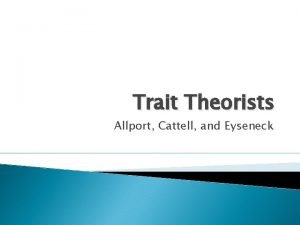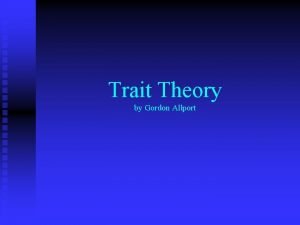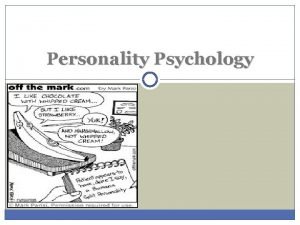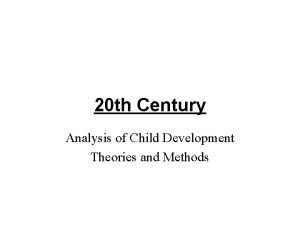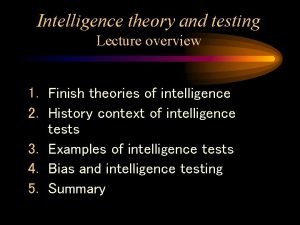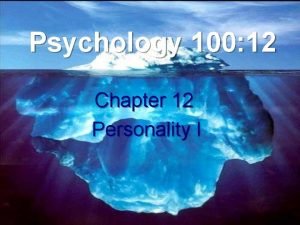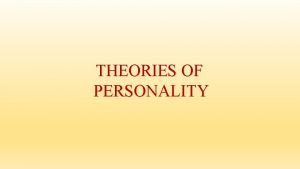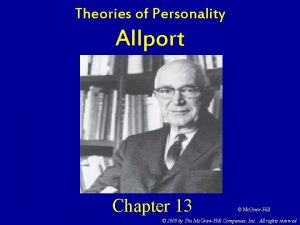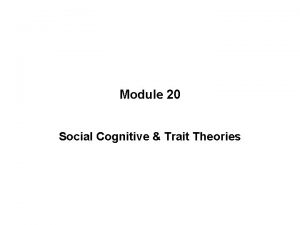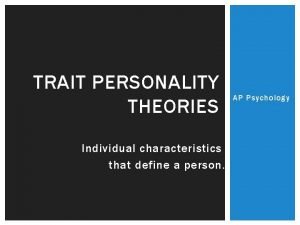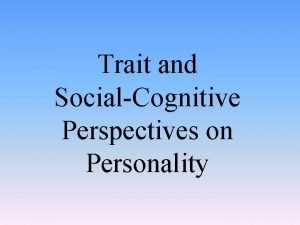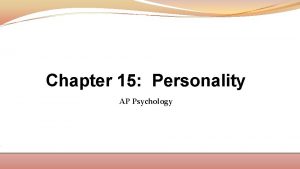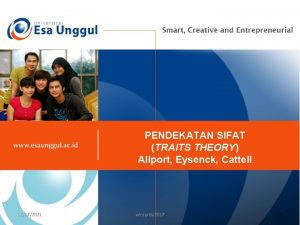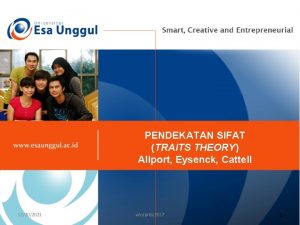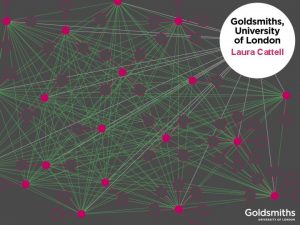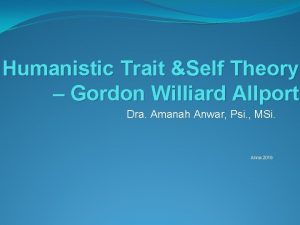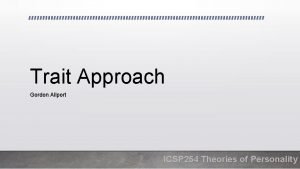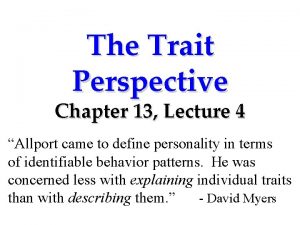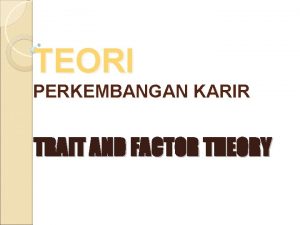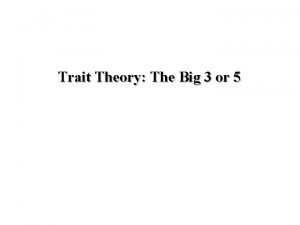Trait Theorists Allport Cattell and Eyseneck Trait Theory
















- Slides: 16

Trait Theorists Allport, Cattell, and Eyseneck

Trait Theory Practically all personality theorists are concerned with traits. After all, traits are what make us who we are; they are the relatively permanent aspects of each of us evidenced by the consistency in our interactions. Knowing this, what makes the trait approach to understanding personality different from the other theories? First of all, while most theories represent attempts at better understanding the development of personality, trait theorists typically talk very little about development. Second, predicting a person's behavior in a given situation is also not a concern for trait theorists. Third, unlike many other theoretical orientations, trait theorists are interested in the comparison of people through based on not just aspects, but also degrees.

Gordon Allport Gordon was interested in personality, and at the time, personality was not a formal sub-discipline of psychology and it certainly was not as fashionable as social psychology. He completed his doctorate, began studying personality. It is said that he was the first professor to teach a college level course on personality theory, a course that today is required by nearly all undergraduate psychology majors.

Key Terms Allport Cardinal Traits: Traits that dominate an individual’s whole life, often to the point that the person becomes known specifically for these traits. Allport believed these are rare and do no develop until later in life. ◦ Ex. Narcissism, Don Juan, Christ-like

More Allport Terms Central Traits: These are the general characteristics that form the basic foundations of personality. These central traits, while not as dominating as cardinal traits, are the major characteristics you might use to describe another person. Terms such as intelligent, honest, shy and anxious are considered central traits. Secondary Traits: These are the traits that are sometimes related to attitudes or preferences and often appear only in certain situations or under specific circumstances. Some examples would be getting anxious when speaking to a group or impatient while waiting in line.

Raymond Cattell By developing questionnaires and tests consisting of personality characteristics, and analyzing data from report cards of students, evaluations from employees, etc. , Cattell applied this new statistical technique. In 1949, he published his findings in an assessment device known as the 16 PF. According to Cattell's research, human personality traits could be summarized by 16 personality factors (PF) or main traits. He described these 16 traits on a continuum. In other words, everybody has some degree of every trait, according to Cattell. The key to assessment is determining where on the continuum an individual falls.

Raymond Cattell's 16 Personality Factors ◦ ◦ ◦ ◦ ◦ Abstractedness imaginative versus practical Apprehension insecure versus complacent Dominance aggressive versus passive Emotional Stability calm and stable versus highstrung and Liveliness enthusiastic versus serious Openness to Change liberal versus traditional Perfectionism compulsive and controlled versus indifferent Privateness pretentious versus unpretentious Reasoning abstract versus concrete

Raymond Cattell ◦ Rule Consciousness moralistic versus freethinking ◦ Self-Reliance leader versus follower ◦ Sensitivity sensitive versus tough-minded ◦ Social Boldness uninhibited versus timid ◦ Tension driven and tense versus relaxed and easy going ◦ Vigilance suspicious versus accepting ◦ Warmth open and warmhearted versus aloof and critical

Hans Eysenck ◦ ◦ ◦ Identified three dimensions of personality Extraversion (Introversion) Neuroticism (Stability) Psychoticism (Superego function) 1. Psychometric evidence for each 2. Strong biological evidence for each 3. Make sense theoretically (face validity)


Application of Trait Theory * If you look at theories , one may start to notice some commonalities. Many different researchers, from different schools of thought have studied the aspects of personality and several interesting similarities have evolved. While different theorists may use different terminology, five factors or personality traits have shown up in a rather consistent pattern. These traits, now known as the Big Five are Openness to experience, Conscientiousness, Extroversion/introversion, Agreeableness, and Neuroticism. These five traits, according to many, make up the OCEAN of human personality, as the acronym goes, and are often considered to be the basic traits under which all other aspects of personality fall.

OCEAN Openness to experience: Conscientiousness: ◦ the dimension ranging from outgoing, liberal, interested in new things, and imaginative to reserved, conservative, traditional, and conforming. Like all of these five traits, people will fall somewhere on a continuum, with most falling somewhere in the middle. ◦ the continuum ranging from organized, careful, and determined to careless, and weak willed. Those on the high end of this factor may be seen as stoic, cold, and methodical. Those on the low end may be seen as gullible, followers, or may see the needs of others as always superseding their own.

OCEAN Extroversion: A person who prefers group activities, group sports, large gatherings, lots of friends and acquaintances, loud music, and social endeavors. An introvert prefers more solitude, quiet music, small groups or individual sports and would rather stay at home or engage in a small group activity than attend a party or large social gathering.

Extrovert vs Introvert Extroverts tend to get bored more easily and may be followers who seek out others to avoid this boredom. Introverts, on the other hand, tend to become anxious more easily, especially in larger groups, and prefer the individual activity to avoid this anxiety, and as more of an individualist, may be seen as more of a leader.

OCEAN Agreeableness ◦ The extremes of stubborn versus easy going or suspicious versus trusting. Those high in agreeableness are helpful, sympathetic to others, and understanding. Those low on this trait are seen as argumentative, skeptical, and strong-willed. Neuroticism: ◦ The dimension of emotional stability. Someone high on neuroticism would exhibit an instability in his or her emotions, interactions, and relationships. They may have frequent and wide mood swings, be difficult to understand, and become more upset over daily stressors and interactions. The person low on neuroticism may be seen as reserved, calm, and perhaps even unemotional.

Application of Trait Theory One of the most obvious applications of understanding human traits is our ability to then measure these traits. Most of the assessment devices that result from trait theory are self-report type tests. In other words, the person being tested responds to questions and these responses may or may not be accurate. People can lie on a test, they can fake bad or fake good, or they can purposefully try to manipulate the results.
 Trait theorists are more concerned with
Trait theorists are more concerned with Gordon allport traits
Gordon allport traits Personality psychology
Personality psychology Gordon allport teoria da personalidade
Gordon allport teoria da personalidade Copyright
Copyright Trait theorists
Trait theorists David wechler
David wechler Situationist theory
Situationist theory James hall and cattell
James hall and cattell Theories of personality
Theories of personality Allport theory
Allport theory Social cognitive personality
Social cognitive personality Cattell's 16 personality factors
Cattell's 16 personality factors Cattell's 16 personality factors
Cattell's 16 personality factors Cattell's 16 personality factors
Cattell's 16 personality factors Cattell intelligence
Cattell intelligence Raymond cattell ap psychology
Raymond cattell ap psychology
